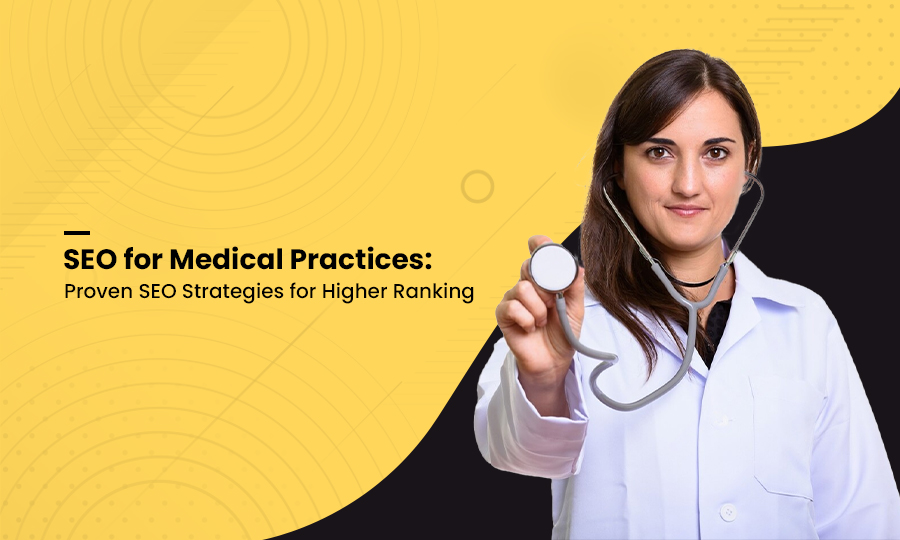You have just opened your medical practice in the neighborhood. Your doctors are highly qualified and you are also equipped with cutting-edge technology. However, no matter what you do, your patient visits just do not seem to increase. There is one simple solution though: SEO for medical practices.
Whether you have the best equipment or the most dedicated doctors, your medical practice will fail to succeed if you do not have enough patients. This happens because of poor digital visibility. Search engine optimization (SEO) helps doctors to expand their presence beyond their immediate locality. It is a relatively inexpensive and one of the most effective healthcare marketing trends that helps medical practices rank better in their search engines.
In this guide, we are going to talk about some of the best strategies to effectively use SEO for Medical Practices. Our carefully curated tips and tricks are sure to boost your online image and visibility to potential patients.
What is SEO for Medical Practices?
For medical practices, an SEO strategy encompasses techniques like social media marketing, developing premium quality content, obtaining good quality backlinks and keyword research. These strategies are tailored to specifically assist medical websites to get a better ranking in their medical search engine results.
SEO for doctors is essential for building credibility and trust with potential patients. Therefore, medical SEO must be used by medical practices intending to expand their services and acquire new patients.
Why is Search Engine Optimization crucial for Healthcare Professionals?
SEO plays a crucial role for healthcare professionals in attracting new patients. This is because it elevates your digital presence and makes it simple for patients to identify and find out about your medical practice. Such a marketing strategy intends to improve search engine rankings and business listings.
Let’s take a brief look at the reasons why healthcare SEO is important for doctors and medical practices.
1. Increased Visibility for Your Medical Practice
SEO for medical practices helps doctors to achieve good medical search engine rankings. This is because a well-planned SEO strategy will make sure that organic research results lead to higher traffic for your clinic’s website. Additionally, robust SEO efforts also improve the functionality of your website leading to better trust among your potential patients.
2. Boosts Digital Presence using Search Engines
A good online presence is important for any healthcare organization. Using social media platforms as a part of your medical SEO strategy enhances engagement and visibility within the clinical community. Further, paid advertisements can supplement local SEO efforts and lead to prompt results for your marketing campaigns.
3. Improved Business Listings
Having correct business listings is an essential component of any medical facility practising local SEO strategies. These lists can help potential patients identify important information about your practice. Additional SEO efforts like digital marketing also bring long-term success to medical practices by improving patient engagement.
4. Growth in a Competitive Medical Market
SEO for medical practices is also crucial for successful digital marketing. This is because effective healthcare SEO strategies can help medical businesses stand out from their competitors. It further supports patient acquisition and efficient service expansion.
Top 9 SEO Strategies for Medical Practices
Consumers search the Internet when looking for clinical care, dentists, doctors and other medical services? Moreover, 65% of patients look up to Google first for clinical advice before talking to their practitioners.
Therefore, it’s a no-brainer that your digital marketing presence is crucial to boosting the online visibility and patient turnover of your medical practice. Implementing online practices like SEO is one of the best decisions you can take to extend your reach and increase your revenue. Keeping this in mind, we have compiled a collection of top strategies to incorporate SEO for medical practices.
1. Design a User-Friendly Website

Firstly, your medical website must appear professional. It should contain all the important information about your practice and still be concise enough to not burden potential patients with loads of information. Additionally, the website should also look user-friendly so that patients can navigate easily.
Your medical website SEO strategies can either make your online image look boring or extremely smart and interesting. All of this simply boils down to the design of your website. For example, a patient visiting your webpage will likely be impressed if it has easy access to different services, appointment bookings and doctors’ details. In contrast, your patient can also feel frustrated if the same website lags or is not optimized to their phone screen – especially if they are in a hurry to look for the nearest clinic!
Since a website is so important in the field of healthvare, it’s important to strive for perfection. Moreover, Google as well as other search engines, take navigation ease, mobile friendliness and website responsiveness very seriously. Therefore, it might be a good idea to take the help of a professional medical SEO agency to make your webpage look top-notch for potential customers.
Additionally, let’s take a look at some quick tips to make your medical website look user-friendly:
- Prioritize mobile optimization
- Select a good color scheme for your website
- Provide easy access to different tabs
- Incorporate user-friendly content
2. Keyword Research
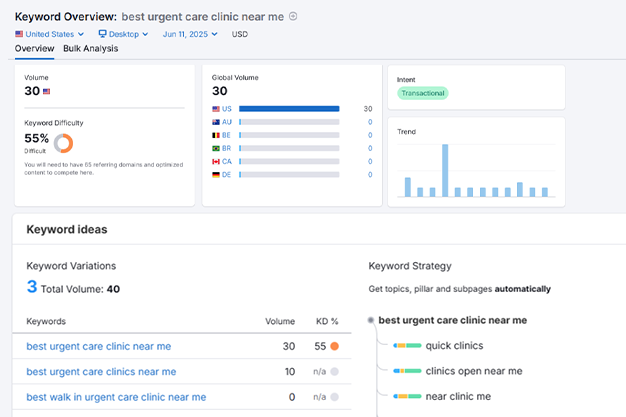
SEO for doctors isn’t as easy as it sounds – especially considering the growing competition in the healthcare industry. Any healthcare SEO strategy requires careful process, planning and execution. Keyword research plays a big role in SEO for medical practices. It comprises finding relevant keywords that align with the search queries of your patients. It forms the backbone of medical SEO processes by expanding the reach of doctors.
However, it’s important to use keywords carefully. While there are countless keywords relevant to SEO for doctors, you would need a large domain to fully reap their benefits. For example, if you’re new to the healthcare industry, chances are that your medical practice does not have the authority required for using competitive keywords like “best surgeon” or “best general physician”.
A good idea would be to use long-tail keywords that are not too competitive but have commendable search volumes. Examples include, “best urgent care clinic near me” or “doctors for urgent bookings”.
Tools like SEMrush, Ahrefs, and Google Keyword Planner can help you find appropriate keywords for your practice. These resources can promptly conduct keyword research that is relevant to you. Here are a few more tips for finding keywords relevant to practitioners:
- Research seed keywords
- Analyse the search intentions of your target audience
- Optimize your website using long-tail keywords
- Consider keyword difficulty
- Ensure that your targeted keywords are of a good volume
3. Content Marketing

This is the strategy of creating visual and written content based on the preferences of the target audience. This can be done both externally and internally on the website. It includes several techniques like making interesting videos, webinars, podcasts and infographics that are optimized to appear at the top of search engine results.
Doctors have always limited their marketing strategy to simply include written content on their website. However, in today’s vast digital landscape, healthcare providers must leverage multiple channels to drive traffic and enhance patient reach. A good way to start this is to publish well-researched, premium-quality blogs. Each post should be optimized with relevant keywords while also offering useful medical advice to patients.
There’s another tool that can be used to maximize SEO for doctors or other medical practices- Email Marketing!
This is when emails are used to share useful medical advice coupled with promoting the practice’s services and products to potential customers. For example, these can be emails updating loyal patients about their appointments as well as medical advice on common health conditions. Additionally, you can even publish educational newsletters and digital brochures every week with backlinks to your website. For example, this could be a blog titled “Healthy Eating Tips to Control your Blood Pressure”, followed by a link to your medical practice’s dietician profile. Such content establishes a professional image of your practice while also attracting patient engagement and online visibility.
To sum up, here are some top content marketing strategies that can boost your medical practice’s position in the search engine results:
- Press Releases
- Brochures
- Medical eBooks
- Social Media Posts
- Medical Blogs
4. On-Page SEO for Medical Practices
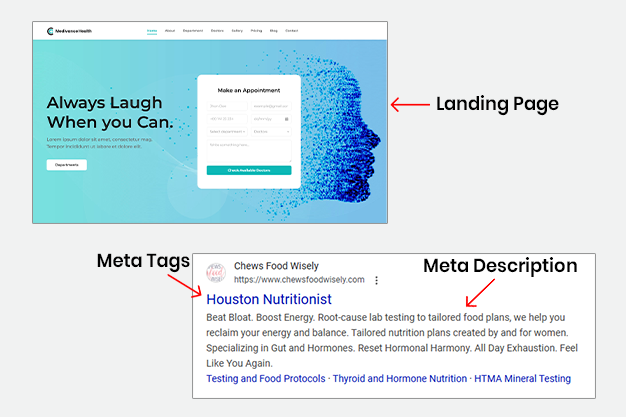
This strategy includes a collection of diverse optimization processes that can be seen in your medical SEO website. To implement this, you can develop some appealing landing pages. These could include one page for every service or department offered by your medical practice.
For example, these could include pages on physiotherapy, chiropractic services or even acupuncture therapy optimized to SEO for occupational therapists. Moreover, having more service pages is sure to give your medical practice a competitive advantage by increasing your credibility.
Additional ways to incorporate on-page SEO for medical practices are meta descriptions and meta tags. Meta tags are the titles of websites that we see in blue in the search engine results. Meta descriptions provide concise information about your page and must be optimized with relevant keywords for maximum reach.
To further maximise the potential of your meta descriptions during search queries, include the major USPs specific to the service page. This is sure to attract potential patients to your website in their Google search results.
Adding H tags is also an important strategy in the field of SEO for medical practices. These tags make your content look structured and seamless instead of big chunks of text. Handling H tags can be a little tricky, which is why you might want to take the help of medical SEO services.
Regardless, here’s a quick summary of optimizing on-page SEO for doctors:
- Use premium metadata
- Add at least one landing page for each of your services
- Use keywords to optimize your website content
- Add H tags to structure your content
5. Local SEO
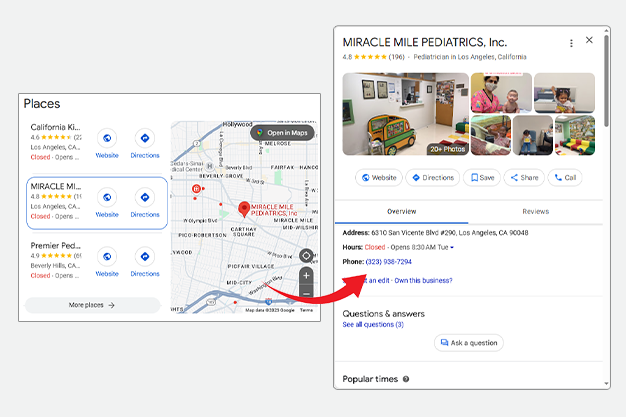
This is a marketing strategy that improves the rank of a healthcare website on local search engines. Unless your medical practice works at an international level, local SEO for doctors is crucial for boosting the digital image of your medical practice. Moreover, if you are new to this field and have recently opened your clinic, it is all the more important to rank on local Google search results to attract new patients.
While national-level SEO techniques can gather lots of traffic, they may not be useful in driving local patient communities to your clinic. This is because while searching, patients generally look for specific medical practices online. For example, this can be, “pediatrician near me” or “dietician in Los Angeles”. Optimizing local SEO becomes important to rank for these keywords.
Almost a third of mobile searches are linked to location. This makes it even more important to leverage local SEO. Launching a Google Business Profile (GBP) is a great way to optimize local SEO for your medical practice.
Once you claim your GBP, include important details such as the name, contact details, working hours and location of your medical practice. If your medical practice operates in two locations, make sure the Google Maps for each location is optimized for easy accessibility to patients.
As a marketer trying to boost your medical practice, the aim should be to obtain a ranking in the Google Local 3 pack. This will enable your clinic to come up in search queries when a patient makes a location-oriented search in Google. In summary, here’s a quick list of tips for using local SEO for medical practices:
- Obtain local backlinks
- Optimize your website with local keywords
- Optimize the Google Maps location of your clinic
- Claim your GBP for improved visibility in local Google search results
6. Technical SEO
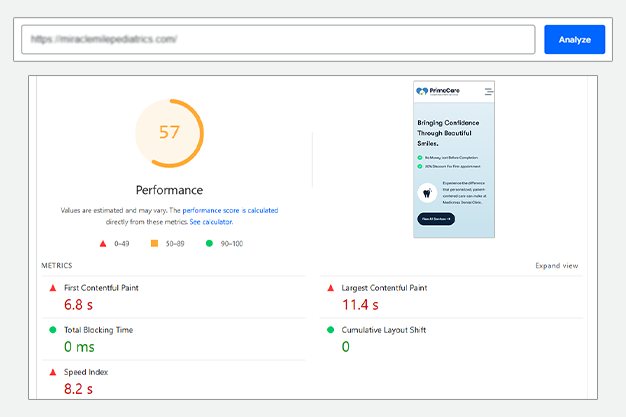
This includes all the techniques that make it convenient for search engines to find and index the pages from your medical website. To begin, you need to first technically audit your website to identify any errors or inconsistencies.
Technical SEO is one of the most essential strategies of SEO for medical practices. It primarily consists of two parts – mobile optimization and speed optimization.
To optimize your medical practice with the first strategy, you need to use a responsive rather than an adaptive design for your mobile website. This will make it much easier for you and your patients to navigate your web pages. It is because a responsive design will ensure that your website aligns with diverse screen sizes without any lag.
Another important factor is page speed optimization. For example, imagine navigating an online appointment or a page from a clinic that takes ages to load. Wouldn’t it be so frustrating? In addition to speed, remember to check your practice’s website for other issues like broken links, duplicate content and secured socket layout.
Here’s a quick checklist to brush up on our knowledge of technical SEO for doctors:
- Apply canonical tags for duplicate content
- Correct broken links
- Check the core web vitals of your website
- Apply a responsive and speed-optimized design
7. Social Media Optimization
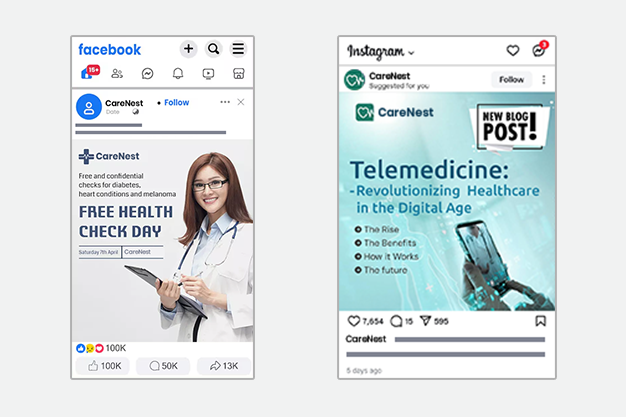
With Facebook, Instagram and LinkedIn being so popular nowadays, there’s no doubt that people currently are always on their phones. This is an excellent opportunity for your medical practice to create a social profile and start engaging with your patients.
This healthcare SEO strategy is when practices and healthcare providers promote their services across diverse social media channels. For example, this can include opening an Instagram or Facebook page for your clinic. Remember to add details like the location, images and contact details of your clinic. To further expand your reach, add relevant hashtags to your content and keep interacting with your audience in the comment section.
Here are a few more tips and tricks to optimize your practice’s social media accounts:
- Create profiles across multiple channels for maximum reach
- Add updated pictures of your clinic
- Include basic information about your clinic so that patients can find you
- Publish frequently
- Interact with patients in the comment box
- Respond to negative comments professionally
8. Earning & Acquiring Backlinks
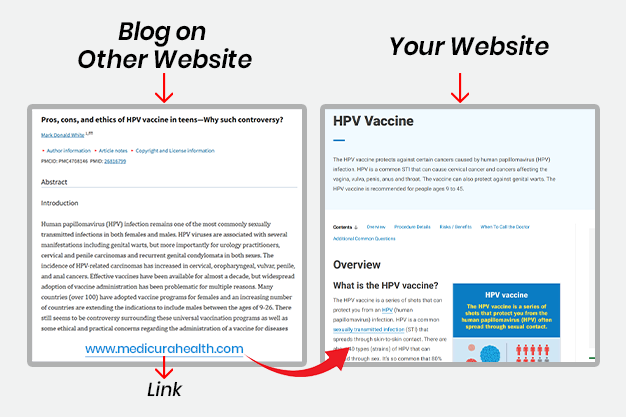
This is when links from another website direct consumers to visit your medical practice’s website. They are also known as incoming or inbound links. For example, a blog titled “Why you should take an HPV vaccine” from a different website can add a link to your clinic’s webpage on immunization services.
Backlinks may sound like a thing of the past but are a game changer for healthcare SEO. A common strategy to utilize them would be to add backlinks to guest posts. However, your clinic can also earn backlinks if you rank high on the results pages of search engines. This can only be done by creating and publishing premium quality content that patients perceive to be valuable.
Such content will not only help you earn backlinks naturally but will also position you as an important authority in the healthcare industry. Let’s sum up the main points for creating a strong backlink portfolio for your medical practice:
- Prioritise natural back-linking
- Remember to get high-quality backlinks from relevant sites
- Remember that good link-building takes time to show results
- Obtain links with high domain authority
9. Reviews
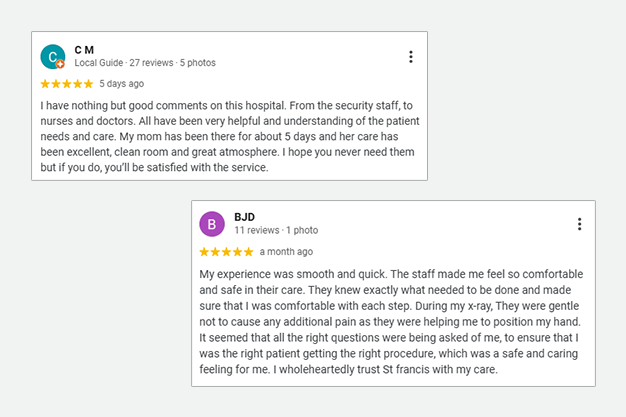
Picture this example – You are looking for a family physician in your locality and stumble upon a promising medical website. However, as you navigate their website, you find that their Google pages are filled with either two stars or negative patient reviews on complaints like long waiting times or rude staff behaviour. Would you want to further explore or even set foot in such a clinic?
Online reviews play a big role in impacting a patient’s decision before visiting a medical practice. That is because, in healthcare SEO, search engines identify these testimonials as the true experiences of your patients. This further leads to better rankings for your healthcare website. If all of this sounds too overwhelming, feel free to work with a PR or online reputation management company to enhance your brand image in the healthcare industry.
Further, patient reviews are an important part of healthcare marketing. Not only does it help to increase patient loyalty, but it also helps your medical practice get new patients. This can be done in two ways. Firstly, you can tell your patients to leave a review once their treatment is completed in your practice. Secondly, you can also request reviews and feedback through email and SMS automation. For example, once you complete a root canal treatment, you can receive an SMS that reads, “Are you satisfied with our dental services? Leave a review for our doctors!”.
Common Medical Search Engine Optimization Mistakes to Avoid
Despite its effectiveness, a few factors can make or break your SEO strategy. Errors in SEO for medical practices can strongly affect the digital visibility of your clinic. To support your medical practice in ranking higher across search results, let’s take a look at some prevalent medical SEO errors that you should avoid.
1. Avoiding Mobile Optimization
As of 2014, almost 62% of mobile phone users obtain medical information from their phones. This includes searching for data on specific health conditions, nutrition or fitness-related concerns. Therefore, creating and optimizing a mobile website for your medical practice is paramount for successful healthcare marketing.
A major mistake while implementing SEO for medical practices is when you do not make a mobile-friendly website for your clinic. With more and more patients looking for healthcare information from their smartphones, not having an optimized mobile website can significantly harm your healthcare SEO performance. Further, Google gives more priority to websites that are mobile-friendly making it even more essential to prevent this error.
For example, a medical practice in Brisbane does not create a mobile website for its clinic. Alternatively, their current website keeps lagging on the phone due to no optimization. As a result, the practice fails to capture a large community of potential patients who prefer to access healthcare information, including access to doctors from their phones.
The best solution would be to optimize the website of the medical practice for smartphone users. This can mean modifying the website’s content to fit various phone screens and resolutions. It can also include icons that instantly connect the patient to preferred links like booking online appointments, tracking their medication orders and so on.
2. Excessive Clinical Terms
Giving the correct medical information is undoubtedly essential for your website. However, using too many complex medical terms can ward off any potential patients. The website for your medical practice must be easy to understand for many consumers. Not only will patients find your content useful for their medical conditions, but it will also help your clinic be found easily on Google.
For example, your medical practice publishes a blog titled, “The Pathophysiology and Therapeutic Management of Diabetes”. While the blog may share valuable information on the causes and treatment of diabetes, most patients may not know the meaning of terms like “pathophysiology” or “therapeutic management”. As a result, customers fail to engage with the blog, leading to poor traffic and low acquisition of potential patients on your website.
To resolve this issue, substitute complex medical words with simple ones. For example, instead of the previous title, your blog can read as, “What Causes Diabetes and How Can You Treat It”. This will not only make it easier for patients to understand but also keep them hooked to your content leading to more traffic.
3. Not Updating Google My Business Profile
Many clinical practices forget to update their Google My Business (GMB) Profile. It’s very important to keep updated details about their address, operating hours, services and contact number. Not paying attention to your GMB can prevent patients from contacting you leading to poor conversion and engagement rates.
For example, your medical practice has a GMB profile. However, you have not added details about your operating hours, the address and the kind of services provided by your clinic. An effective medical SEO would be to update these details and add patient reviews to your profile. This will differentiate your medical practice from other competitors and prompt new patients to reach out to you with full trust.
Conclusion
SEO for medical practices can be a complex process. Once implemented, it is sure to give you long-term results. If you are interested in boosting the growth of your medical practice, effectively leveraging the power of a premium healthcare SEO strategy is your best bet!
If you are an expert in the medical and digital marketing industry, you will surely be able to reap the benefits of your medical SEO efforts. Alternatively, if you are new to the world of SEO for doctors, working with a professional healthcare SEO company may be a good idea as they specialize in SEO for medical practices. In today’s digital world, the online presence of your clinic is directly proportional to your patient engagement and credibility. Therefore, it is better to take expert advice rather than risk when it comes to SEO for medical practices.
Additional Resouces:



























